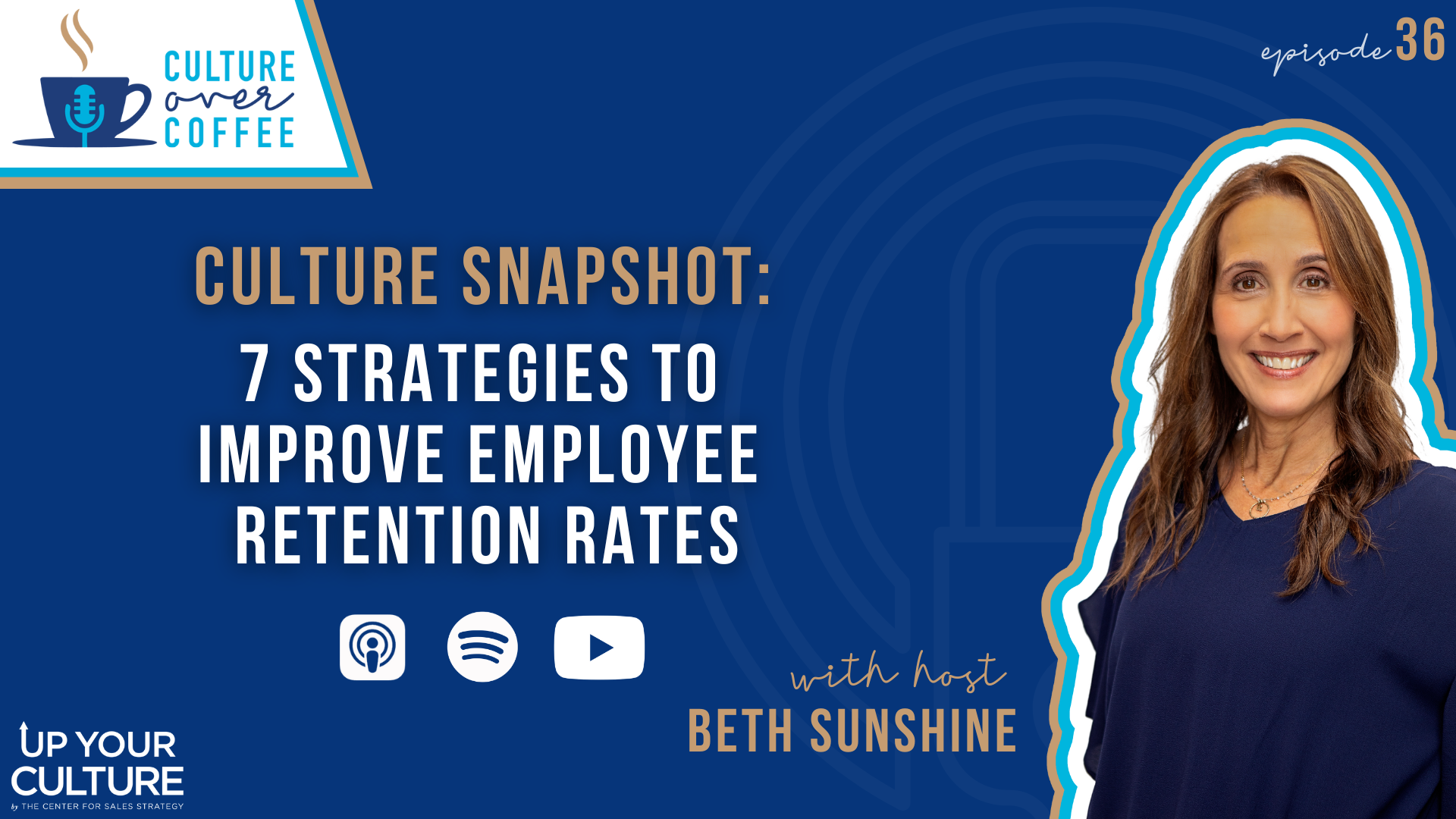
Today’s topsy turvy job market has led to an abundance of job openings and a candidate-centric job market.
Employees looking for a job are now in the driver’s seat, enjoying the increased flexibility they have in selecting a workplace. Employers, on the other hand, are scratching their heads, trying to figure out how to attract the talent they’re looking for. It’s become crystal clear to everyone that a few “fun” perks like a beverage cart or a ping pong table just won’t cut it anymore. People want more out of their work.
The path to attracting top talent and preventing costly employee turnover begins with creating a strong and intentional company culture. In this two-part series, we have compiled for you the Top Ten ways you can create a strong company culture and engage your employees, so they don’t want to leave!
1. Identify and Measure Your Current Culture and Level of Engagement
Culture is powerful and has a direct effect on employee engagement.
Every company has a culture, but many company leaders aren’t clear on how their employees perceive their culture today or how their culture compares with their ideal. Even at the best companies, when culture droops, employee engagement plunges, and that has a massive impact on performance.
Companies find they can have the most talented people and the best systems, products, or services, but if their people aren’t engaged, they will often mentally check out or even physically leave their job. Either way, the company can’t reach its full performance potential.
- Step number one is to determine the culture you want to have in your organization.
- Then use an effective culture and engagement survey to measure your current culture and level of employee engagement.
- Finally, dive into the data to fully understand the stories it tells. Discover exactly which factors have the highest impact on engagement and create a strategic plan to improve in those key areas.
2. Create a Shared Mission
A Jobvite survey of people who had left a job within the first 90 days showed that 32% point to company culture as the reason for their departure.
A great way to combat that is to create a shared mission that gives them a clear sense of where you’re going as a company and why you’re all working so hard to get there. A shared mission drives employees to feel as though they have a stake in the game and a sense of purpose in their work. It defines exactly what they’re playing for and how they can win.
Start by working with your team to create a compelling Reason for Being (or Purpose Statement) that articulates why your employees get out of bed every day to do the work they do. This statement will make clear why their work is important, rally people to join a cause greater than themselves, and give people a strong sense of purpose and belonging.
Then establish clear Core Values that will serve as your true north on this mission. Your values should describe how people will their coworkers and their customers. Great Core Values provide employees with the rules of the game for success in their organization, so they never question what behaviors are expected and which won’t be tolerated.
3. Create Psychological Safety
For teams to work well together, team members must feel comfortable enough to be their authentic selves and share their thinking with others. Only when employees are able to share their unvarnished ideas, questions, concerns, and mistakes (without embarrassment or fear of being rejected, punished, or humiliated), can they fully contribute.
Google conducted a two-year study of 180 companies on their quest to discover and define what makes the perfect team. That study, called Project Aristotle, found Psychological Safety to be the most important factor in team effectiveness. Google confirmed that without it, people won’t ask important questions or speak up and share valuable ideas, which in turn leaves company leaders without all the information and insight they could have to make strong business decisions. When Psychological Safety is lacking, employees are also more likely to misread each other, hampering communication and diminishing the effectiveness of giving and receiving feedback.
- Challenge yourself to increase the sense of Psychological Safety on your team by listening more and talking less
- Sharing your own failures
- Allowing others to be seen as the “hero"
- Asking for help when you need it
- Freely giving help when asked
4. Develop Your People
People need to feel as though they are growing in their jobs and developing their skills over time, or they can begin to feel stagnant and disengaged. As a people manager, this is especially challenging because no two employees on your team are the same. Each person you work with has their own personal growth goals, a different work style, and a set of strengths and weaknesses as unique as their fingerprints.
Great people development takes time, thought, and planning. Most people managers have a lot of other responsibilities on their plate as well, so time is rarely abundant, but it can still be done!
Here’s how:
- Start by using a validated talent assessment to accurately identify everyone’s innate strengths and weaknesses as they relate to their specific job role. This will tell you what they need from their manager to maximize their strengths and excel in the job.
- Then create a list of questions you can ask to better understand how they want to be managed. We use a tool called the Growth Guide, but you can also design your own list of questions to better understand what gives them energy in their role and what depletes them, what their personal goals are and how they plan to achieve those, how they like to communicate with and learn from others, and how they prefer to receive recognition.
- Armed with the information gleaned from both of these instruments, identify three specific strategies you will use to develop each person you manage. Challenge yourself to refer to those strategies regularly and put them on your calendar, so they don’t slip through the cracks.
5. Recognize and Reward Good Work
There is a common misconception that you must use recognition sparingly because if you give it too often, it will come to mean less to those who receive it. Many managers also believe that recognition must be tied to financial rewards for it to be meaningful, which makes it cost-prohibitive. Unfortunately, these mistaken beliefs often lead to the single greatest missed opportunity for increasing engagement.
Recognition is a powerful motivator for people, making them feel appreciated and valued for their work and giving them a sense of accomplishment. Meaningful recognition boosts engagement, increases productivity, creates stronger feelings of company loyalty, and improves employee retention. It also demonstrates to other employees what success in your company looks like. As a result, recognition serves both as a personal reward and a strong reinforcement for the desired company culture.
- Consider how you can give your employees an immediate raise in praise.
- Begin this low-cost endeavor by considering what each person is doing right.
- Then, consider the best way to provide recognition to each individual. Some people will appreciate a phone call or a live conversation, some will prefer an email or a text, and some will especially value a personal note mailed to their home.
- Regardless of how you communicate it, the key is to be authentic as you share with them the behaviors you have seen and why you value them.
- From that point forward, make a commitment always to provide people with a pat on the back when they deserve it. Don’t worry about overdoing it! As long as you’re authentic, your people will value your thoughts and come to crave them more often.
With these first five tips in mind, what can you do to increase engagement and prevent turnover on your team?
We’ll suggest five more in Part Two next week!


![5 Tips for Preventing Turnover [Part 1]](https://uyc.thecenterforsalesstrategy.com/hubfs/UYC%20Turnover.png)









Leave a Comment